Morals
 |
 |
 |
 |
 |
 |
 |
Moral Questions
What Is the Catholic Doctrine on Dance?
Hello TIA,
I would appreciate your take on dancing. When it is right to do it; when it is not. I know the Catholic Church has restrictions and I agree. But, I wonder if there is any dancing that is correct, such as folkloric dancing.
Thank you in advance.
I follow your site every day.
In Christ Jesus,
E.J.
______________________
TIA responds:
Dear E.J.,
Unfortunately today, when we live in an atmosphere of complete moral tolerance for all the vices as a consequence of Council Vatican II, it is not rare to see a weak moral approach, even in conservative and traditionalist priests. Although these priests often take good positions on other topics, when it comes to dances, they orient their parishioners in a way that, before the Council, would hardly escape a reprimand.
Your question gives TIA the opportunity to provide an extended answer on the topic to help you and, also, those faithful who have uncertainties on the matter, so that laymen can clearly see what is correct and act accordingly.
This answer is based on the text by Fr. Théophile-Marie Ortolan O.M.I. – Oblates of Mary Immaculate – (1869-1937). He wrote an extensive article on dance for the Dictionnaire de Théologie Catholique - DTC, which is a collection quite prestigious for its scholarship. If any criticism were to be made of the general orientation of the DTC, it would be that it leans to liberalism in morals.
General principle
Dance is an art turned to express beauty with the means at its disposal. Now, any art, whatever it is, while it expresses beauty is not intrinsically bad. It becomes bad insofar as it is favors bad morals.
History
Dance has existed for as long as recorded history. To be fair, theologians have acknowledged that dance is basically a neutral activity. It can be either good or bad depending on the circumstances and the way it is done.
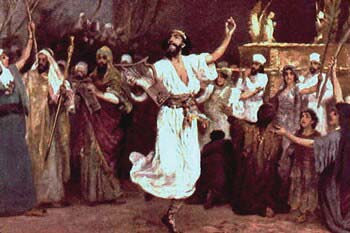
King David dances before the Ark of the Covenant; below, Salome performs to seduce Herod
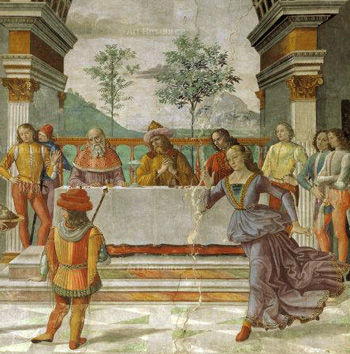
Outside of Israel, the situation was much worse. Many dances of the Greeks and Romans were conceived specifically to provoke sensuality. Often such dances were made in honor of pagan gods, such as Bacchus or Mercury, and ended in orgies. These pagan dances were condemned even by pagan writers, such as Cicero, who denounced dance as the last vice that follows all the other vices (gluttony, vanity, sensuality etc).
Due to the strong influence of Greek and Roman culture, these degenerate dances began to affect the Chosen People. Let us recall that, at the time of Our Lord, St. John the Baptist was beheaded as the result of a sensual dance that captivated King Herod, who promised Salome to grant her any request.
Teaching of the Church
By the time of Our Lord those good ancient Jewish dances had largely degenerated under the influence of the Roman and Hellenic cultures. Later, in the early Christendom, the bad leaven of pagan heathen dance led the Church to condemn dancing as unfit for Christians.
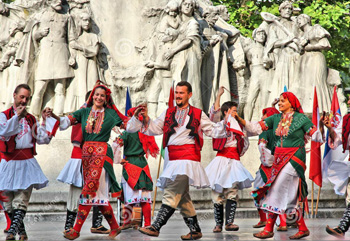
Bulgarian dancers show that sexes can dance together without embracing or dressing immodestly; below, Brazilian gaucho pairs prove the same thing
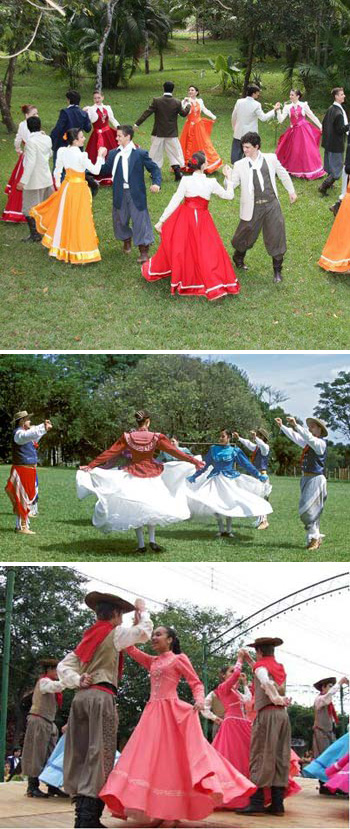
Despite these condemnations a certain amount of liberty has been given for the innocent folk dances that preserve modesty. Children’s dances and military dances also fall into the category of dances permitted.
Fr. Ortolan quotes theologians who stress that dancing can be an occasion of sin, both for oneself and for others. One must be especially conscious of the sin that one may commit by inciting others to sensuality through dance.
Although some folk dances may fall into the category of innocent, it must be remembered that the waltz and the polka were condemned, since they involve embraces, a romantic atmosphere or even the interlacing of fingers. Passions that arise from such dances and balls are considered deliberately provoked temptations. Several theologians state that going to such dances is, at the least, to invite sins of sensuality, and, consequently, this risk may constitute a mortal sin against the virtue of prudence. The musician who provides the music for sensual dances is deemed unworthy of absolution.
Looking at more contemporary times, Ortolan and other theologians condemn the performing arts, such as ballet, that involve tight clothing, pastel or skin colored apparel and revealing or transparent dresses. Such attire alone is deemed a grave sin against modesty and this is often compounded by the illicit and immoral positions and movements that are part of the dance itself. It is not a mark of virtue that one’s sensitivity to such flagrant immorality has been dulled by overexposure to such immodesty, as is often the case today.
The author reminds us that in times when the Catholic Faith and acts of piety diminish, sins in dancing become the rule rather than the exception. He also notes that those who sin in dance are far more numerous than those who do not.
Modern dances
Given this information a few conclusions seem inevitable.
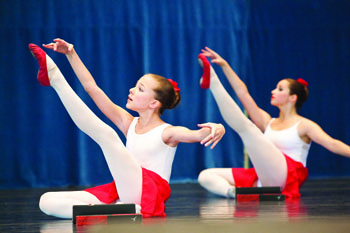
These immodest outfits and poses are not permitted by Catholic Morals
* Regrettably, almost all dances today are unacceptable by Catholic standards. Rock n’ roll, jazz, the twist, swing dancing, and nearly every other dance contrived in the last century – such as tango, samba, rumba, salsa, calypso and even more “conservative” dances like the blues, bolero and fox-trot – fall under the same restriction;
* More rigorously the dreadful-sensual movements that pass for dance in most nightclubs and the modern rock concerts should be rejected.
Criteria for parents
As a practical advice for parents, the general criteria to judge a good dance for a young woman and a young man are to check whether or not:
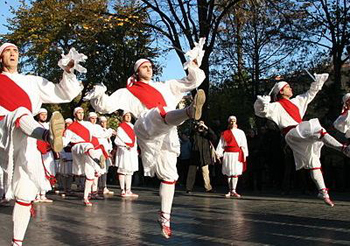
Basque dancers in colorful traditional dress
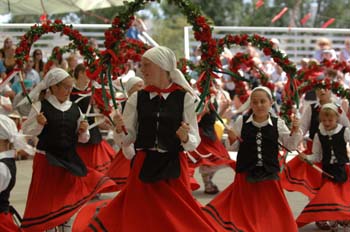
Below, Basque girls learning the traditional folk dances in the town square
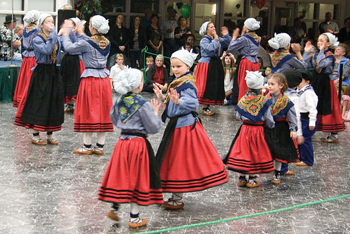
- The dresses are modest – no exposition of the body parts except the head, hands, lower arms and lower legs (skirts below the knees), no transparent or see-through clothing, no tight apparel that reveals the shape of the body, especially when it is skin colored;
- The positions are appropriate – no close embraces where the bodies touch; no leaning of woman’s head on the man’s shoulder; no faces touching; no interlacing of fingers.
- The movements are decent – no sensual twisting or vibration of the waist, no lifting of the legs or jumps that reveal what the dress covers, no fast twirling that allows the skirts to fly outward, no provocative positions of the derrières, no challenging protrusion of the breasts, no languid abandonment of the arms.
We should take into consideration also the dissipating effect dances have on the mind of a Catholic, and think about those who, in contrast, profitably employ their time in prayer and meditation about God.
Even if one avoids the sins of vanity, immodesty, sensuality and indiscretion, we should remember what St. Francis de Sales said: Even the best of balls are of no value.
Cordially,
TIA correspondence desk

Left to right, Greek boys in a circle dance; Italian country women in a local dance; a trained Polish troupe in highly disciplined movements

Posted April 12, 2016
______________________
______________________
 |
 |
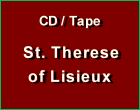 |
 |
 |
 |
 |
 |
 |


